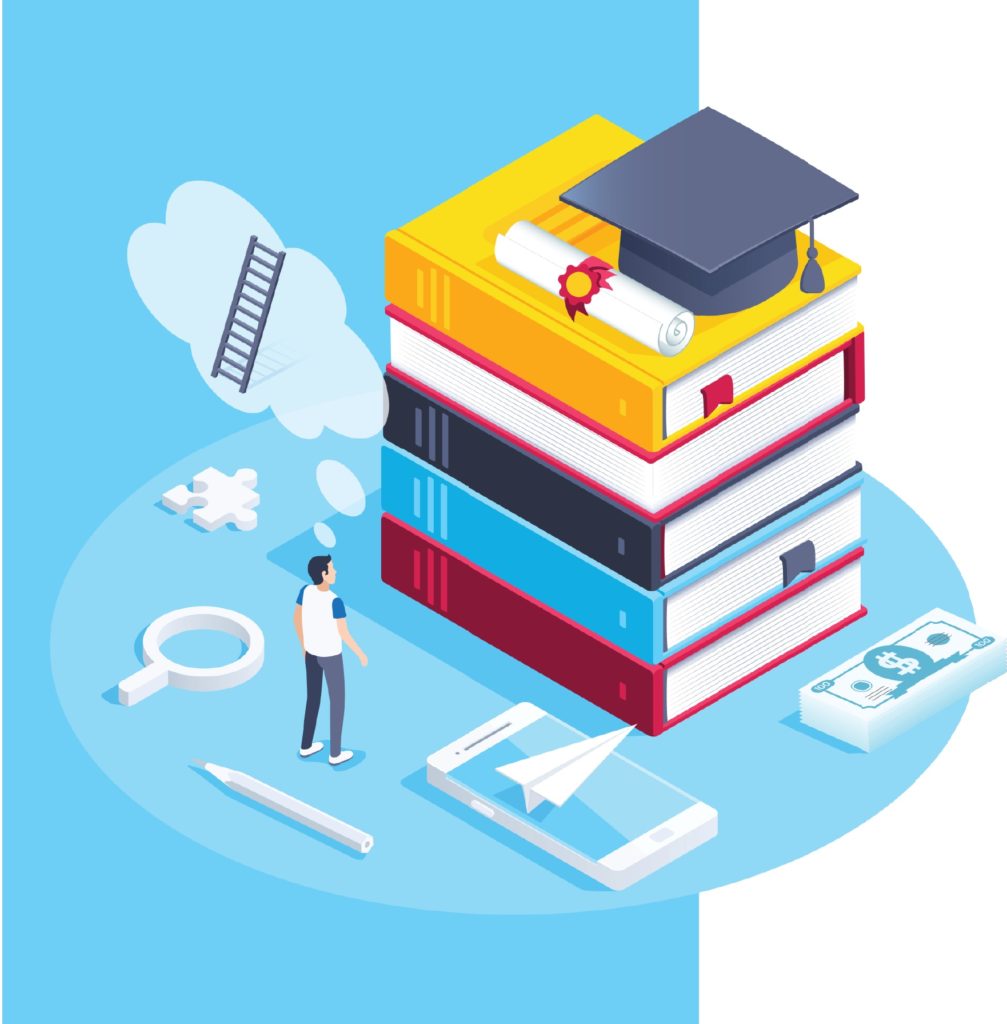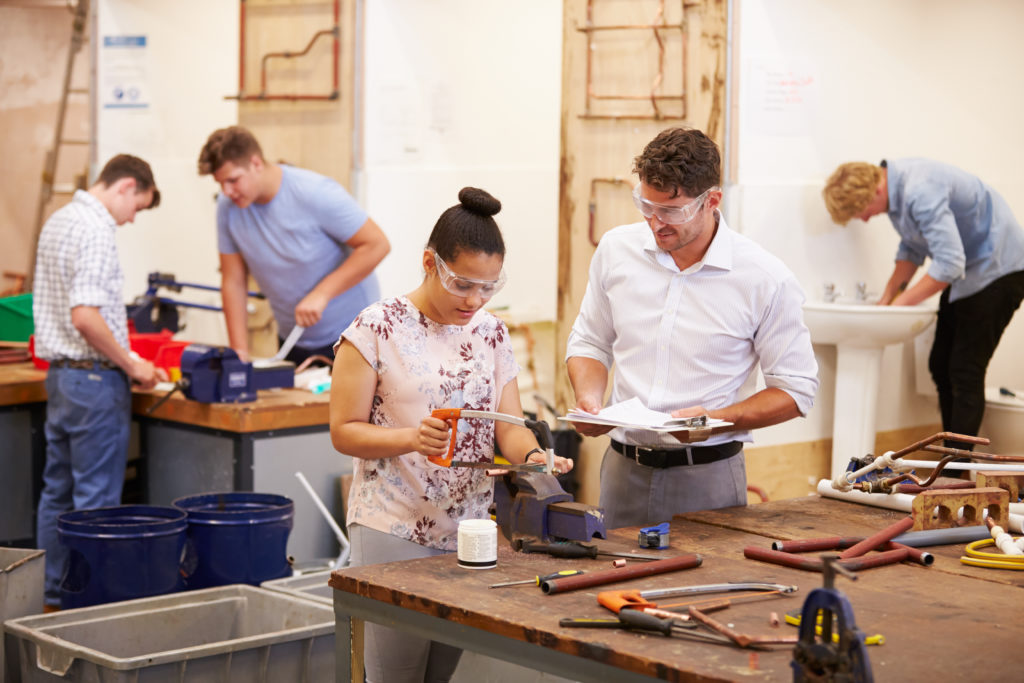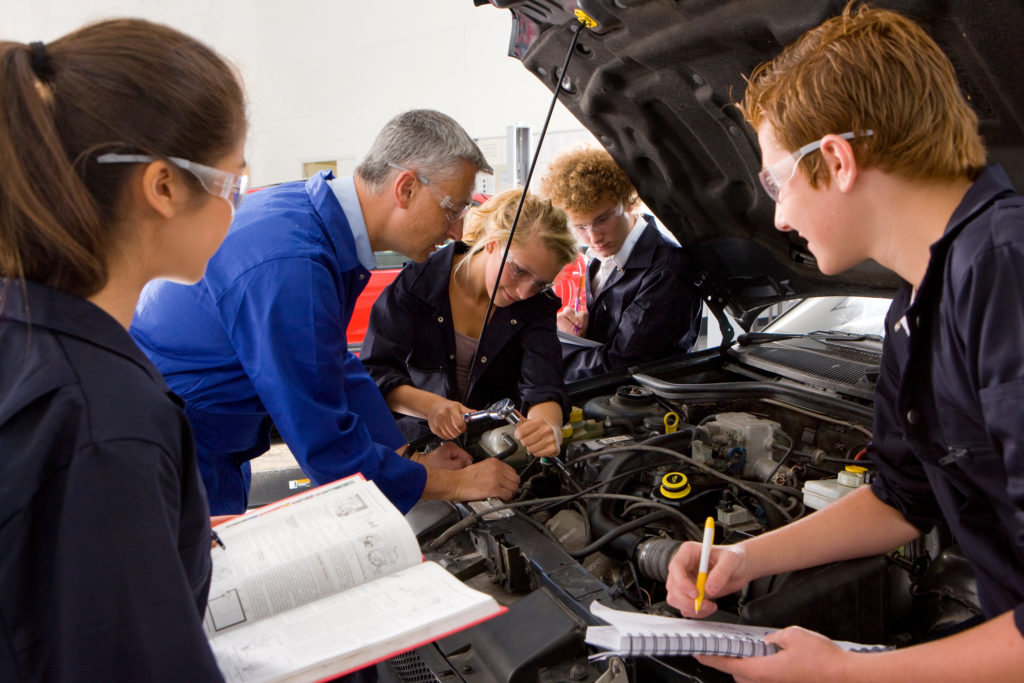Here’s a head-scratcher. Only about 37% of young adults complete a college degree. Yet college—in the traditional sense of a bachelor’s degree from a four-year institution of higher learning that a student pursues full time on campus—is still imaginatively linked with the supposed American Dream and assumed to be the one and only road to success. Now, the simultaneous crises of crushing student debt loads and the complexities of workforce shortages are prompting questions about the return on investment for the usual college path.
College up-close in 2022 doesn’t really resemble the “college” in our minds. It’s an increasingly flexible, adaptable and creative proposition. Increasingly, higher education institutions have had to create opportunities for students to earn credentials in “stackable” increments, through alternative routes such as paid apprenticeships, public-private partnerships or early college programs. The savviest students are letting industry, their K-12 public school system or a combination of the two cover some—or even all—of their college tuition costs.
These varied strategies reveal the efforts of a country to solve a multitude of challenges—for students, who will soon become an indebted and underpaid workforce; for employers and industries at large, standing off against a jaded population (cf., the ongoing Great Resignation); and for higher education institutions themselves, which are increasingly struggling to justify astronomical tuitions and which, according to studies, overestimate their debt-burdened graduates’ entry-level salaries by 100%.
If these strategies are any indication, those institutions may look to public universities as the bastions of progress toward a more equitable playing—or learning—field for the next generation of students. Here, we look at the struggles and successes of a few key strategies as they attempt to reshape the future of higher education.

Reinventing apprenticeships
In 2021, the U.S. Department of Labor found that there were over 85,000 new apprentices age 24 and younger. Still, Noel Ginsburg, founder and CEO of CareerWise Colorado and co-chair of the Advisory Committee on Apprenticeship, which works with the U.S. Department of Labor, still calls his a “nascent field,” whose potential to transform the American workplace and workforce is barely being tapped.
CareerWise, a modern youth apprenticeship company that connects students and employers, draws inspiration from Switzerland’s model of placing 70% of high school students in one of 230 vocational fields, from catering and agriculture to banking and insurance. Switzerland’s economy consistently ranks as one of the world’s most competitive, and its success can be partially attributed to this well-established integration of business and education. It turns out 16- and 17-year-olds might not be willing to make their beds, but they just might make an excellent employee.
The U.S.’s skilled-labor shortage, which CareerWise was created to address, was not a theoretical problem for Ginsburg. As owner of the manufacturing firm InterTech Plastics, he knew about it all too well.
Alumnus Kevin King came on during his senior year in high school and five years he’s an Automation Engineer there. He helped to design systems to make products cheaper to produce, enabling them to compete with Chinese manufacturers, while not sacrificing quality. As an entry-level apprentice, King earned just over $11 an hour. Now he’s salaried at $77,000-plus per year, and InterTech is paying for his bachelor’s degree in engineering, which he’s in no rush to complete.
“Honestly,” Ginsburg says, “it’s cheaper [for a company] than paying a recruiter $40,000 to recruit somebody from Ohio that will move here for a few years and then want to go have kids and go back [home]. The company has won, three years running, the top Innovation Award in the plastics manufacturing field. “This was for projects that apprentices were a part of and, in some cases, drove.”
Ironically, King had veered onto this path the day he dropped off the college track. “In high school, I coasted,” King says. “The fact that I passed so many AP classes is a sign of a failure of the system, and less a sign of my own ability.” He’d identified a passion for engineering while acting as fabrication director for his high school robotics team and was motivated to pursue that vein. “I really liked building things with my hands,” he says.
Today, InterTech’s workforce pipeline relies partly on apprentices. Dozens of other companies, JP Morgan Chase and Amazon among them, are adopting similar approaches.
The move to swiftly scale up game-changing opportunities like CareerWise would seem to be a no-brainer, but there’s a thorny catch: Businesses need skilled workers now; developing them takes time. This is where both old-school partnerships and brand-new collaborations between community colleges and car companies are playing key roles.
Expanding public-private partnerships
When contemplating their futures and weighing higher education options, students may not think immediately of turning to General Motors. Yet the company—and consequently, the automotive industry at large—has had strong ties to students and institutions for decades.
General Motors first reached out to Suffolk County Community College on Long Island, New York, in 1987, looking to house a technical training program. Soon, the company and school were collaborating on a new facility, and, as David Macholz, Suffolk’s assistant dean of transportation programs, says, “That success led to other manufacturers visiting and saying, ‘We’d like to do the same thing.’” Toyota came on in 2003 [and] Honda in 2005, followed by Subaru, Nissan, Fiat Chrysler, Ford and Mercedes-Benz.
It’s a clear win-win. The school handles logistics for its 250 participating students, and the companies supply them with cars, tools, equipment, materials support and instructor training. One day this winning combo attracted an unexpected suitor. “I got a call from a guy,” Macholz recalls. “He says, ‘I’m from Tesla. I’m interested in seeing your facility.’ I thought he was kidding.”
Per usual, the electric vehicle company wanted to do things differently. The eight trainees at Suffolk’s Tesla START program—and those at the eight others around the country—are hired before they even set foot on campus, and due to the proprietary nature of their technology, Tesla provides their own instructors. Students are paid stipends during the 16-week, A-to-Z training course; the company covers college tuition; and upon successful completion of the program, students, having earned a leg-up on the competition, can apply for full employment.
Every year, 250 automotive students move through Suffolk’s automotive course sequence, but with 3,000 registered repair facilities and 400 new car dealerships in the New York metro area, demand is far outpacing supply. The school is looking to expand with development of a new facility three times the size of the current one. If New York’s community colleges are finding it hard to keep up with growth there, just imagine how Austin Community College feels—in a city where 200 people relocate every day, following in the wake of the tech giants who’ve been expanding their Lone Star footprint years before Tesla came to town.
While construction of his “gigafactory” in the city was underway in 2021, and he was anticipating the day when Model Y electric vehicles would be coming off the line, Tesla CEO Elon Musk tweeted an anticipatory request for 10,000 new workers. He’s since more recently doubled that estimate.
Enter Austin Community College (ACC). The school of 70,000 serves Central Texas on 11 campuses in a six-county region the size of Connecticut. A two-year associate’s degree in one of the school’s 100-plus areas of study will set an in-district student back only about $10,000, about a quarter of the median cost of a four-year degree for the 2021-22 school year. ACC has turned into a hub for creative approaches to higher education, and there are now so many Austin companies in the market for skilled employees that the college has created a new leader whose door they can bang down.
Garrett Groves, the college’s vice chancellor for strategic initiatives, connects company and classroom in a role that’s “both external and internal,” with an ever-expanding range of external workplaces in need of his help. “We’ve always worked closely with hospitals, with IT companies, but now it’s the school districts, it’s every level of the aviation industry. Everybody desperately needs people,” he says.
As with Suffolk, ACC’s business partnership model is long-standing. The semiconductor chip-making wing of Samsung came knocking 20 years ago, so that today, Tesla is able to benefit from the infrastructure that’s evolved through that relationship. “The robotics and skill sets needed for both [are] actually pretty similar, so we were able to take that expertise and build a custom program for Tesla,” Groves says.
At ACC, Tesla is also piloting something new. Students are learning not only how to service Teslas but also how to manufacture them. The school’s logo will be on curricula used in Tesla training facilities in Nevada, New York, California, and perhaps one day Berlin and Bangalore. “Ours is the skilled technician training they’ll iterate on, that they’re now going to use across the globe,” Groves says.
Tesla is also partnering with Dell Valle, the gigafactory’s neighborhood high school, on a prototype collaboration that saw more than 60 students sign letters of intent this year to participate in a five-year program that will earn them a high school diploma, an associate’s degree from ACC and enough hands-on training to enter the workforce at an accelerated pay rate. “We’re trying to build models we can scale across the region fairly easily,” says Groves.
Redefining higher ed and destigmatizing vocational education
The scale-up of public-private partnerships can’t come fast enough in the eyes of their organizers. And if industry is suffering a labor shortage, the laborers are just suffering. Community data crunchers in Central Texas have concluded that young people who enter the labor market there bearing only a traditional high school diploma have only a 12% chance of making a living wage within six years of graduation.
Even with an imperative this clear, schools know they’re attempting to turn several ocean liners on a dime. High schools still measure student success by the number of hours they spend in a seat, not by demonstrating mastery in anything particular. To change this system would be to upend more than a century of precedent. There are long-held assumptions on the business side to push through as well.

“Industry doesn’t intuitively think of high school students as possible employees,” CareerWise’s Ginsburg has found. “‘What do you mean,’ they say, ‘I can take a 15-year-old into the business and have an ROI?’ [Employers’] lack of awareness of the potential to their bottom line is a big issue. But if you put a young person in a professional environment, they do listen to their supervisors; they do grow up.”
Perhaps the biggest impediment to real buildout is the cultural stigma around vocational education. “It’s a horrible problem,” Ginsburg laments. “Communities still think—because we’ve been telling them—that a degree is the key to prosperity in America. It’s not.”
David Macholz of Suffolk Community College believes, though, that things are slowly beginning to change in this regard—and credits some of the shift to what the COVID-19 pandemic revealed about how much we depend on our “essential workers.” Automotive jobs never shut down.
The proof is also, increasingly, in the paycheck pudding. “Education was telling students it was a four-year degree or nothing, and now we’re going in the opposite direction. You can make a six-figure salary in the automotive industry, or the construction industry,” Malchoz adds. “There’s a multitude of things you can do to be successful.”
Investing in early colleges
But where does this leave students who do want a traditional four-year degree, or who are pursuing less tangible goals? Apprenticeships and vocational paths are not for everyone, and making a bachelor’s degree more accessible is another way to both tackle the skills gap and expand the life options of the next generation.
Massachusetts was the birthplace of Horace Mann and modern public schooling, so it makes sense that its education department has been investing heavily in creative ideas in this sphere, including early college high schools, which allow students to receive an associate’s degree or two years of college credit by combining high school and college courses while earning their high school diploma. This school year, the state is supporting the pairing of 50 high schools with 28 higher education institutions.
Mount Everett Regional High School is the only partner school serving a rural area. It draws from Sheffield, a town of 3,000 in the far southwestern corner of the state, and several smaller surrounding towns. Fortuitously, the original early college high school, Bard College at Simon’s Rock, lies just a few miles north in Great Barrington. “Rockers” are precocious kids who’ve been starting college before their 15th or 16th birthday since 1966. (Award-winning journalist Ronan Farrow set the record of age 11.) Bard took its early college model on the road 21 years ago and started a second early college high school on the lower east side of Manhattan. The network has since grown to serve 3,000 students at seven degree-granting campuses.
John Weinstein, now the provost at Simon’s Rock, served on the founding team of the New York school, then the Newark school, and helped to design many others. A scholar in Chinese literature with a focus on drama, he’s an advocate for the power of early college to play a role in progressing the country toward educational equity. “Early college has a lot of potential for students who might not necessarily see themself as college-going, for reasons that are often circumstantial,” Weinstein says.
Mount Everett High School’s student population of 200 can now earn at least three, and up to 31, college credits for free during the four years of high school. Classes are taught by some combination of Simon’s Rock professors and their own trained teachers. Flexibility is built-in, and there is no requirement or expectation that students will commit to the college path after high school. “There’s a lot of on-ramps and off-ramps so that a student can give it a try, which can help with situations where the student or the family is not sure,” Weinstein explains.

They’re encouraged to use the program to take on the “gateway” courses, such as math and English courses, as these are often the roadblocks that interfere with college completion, especially for first-generation students. Once those are dispatched with, students, just as they might in the traditional college experience, may select a pathway from among liberal arts, technology, arts, culinary arts or global education that align with their areas of interest. The hope is that 80% of Mount Everett students will choose to participate in the early college option and that some number of them, having encountered college-level coursework, will seek out higher education.
What’s the difference between a high school class and a college class? Beth Regulbuto, superintendent of Mount Everett’s home school district, Southern Berkshire Regional, points to the open access that early college affords. (Advanced Placement courses, the standard path for gaining college credit in high school, use admissions criteria.) She also believes integrating a college ethos into the school will have positive ripple effects. “It’s forcing us to think about aligning our curriculum differently and preparing kids, all the way down to pre-K, so that they’re ready for early college classwork. For example, how do kids own their learning?”
* * *
How long before these alternative tributaries join the mainstream? Maybe sooner rather than later. Superintendent Regulbuto says, “The reason we looked at early college was [that], like, two-thirds of our students were saying, ‘Our family doesn’t do college.’ They’re asking, ‘Where’s the value? Why am I taking out these loans if I can’t find a job that will pay them off?’”
Noel Ginsburg of CareerWise sees the same trend. “The blinders are cracking,” he says. “Parents as well as students are thinking differently about their futures.”
This article originally appeared in the September/October 2022 Issue of SUCCESS magazine. Photos by Shutterstock




